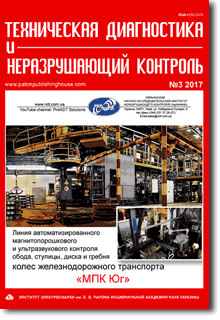Access for download PDF files for subscribers and for reviewers of scientometric bases.
Organization: Elsevier for content access(PDF files of journals released before 2024 are available for download from the website's archives))
Organization: Elsevier for content access(PDF files of journals released before 2024 are available for download from the website's archives))
| 2017 №03 (05) |
DOI of Article 10.15407/tdnk2017.03.06 |
2017 №03 (07) |

Technical Diagnostics and Non-Destructive Testing, №3, 2017 pp. 49-55
Digital radiography with use of composite screens for non-destructive testing in industry and medicine
E. F. Voronkin1, R. O. Pastovensky2
1Institute of Scintillation Materials, STC «Institute of Monocrystals», NAS of Ukraine, 60, Nauky ave., 61001, Kharkov, Ukraine Е-mail: voronkin@isma.kharkov.ua
2E.O.Paton Electric Welding Institute of the NAS of Ukraine, 11 Kazimir Malevich str., 03150, Ukraine. E-mail: office@paton.kiev.ua
The possibility of using dispersed scintillators of a large area for flaw detection of metal products instead of an X-ray film based on scintillation screens ZnSe:Al, characterized by a maximum of luminescence in the area of photoabsorption of zinc selenide, is shown. The experimental data on the dependence of X-ray absorption by specimens using scintillation screens based on the chalcogenide scintillator of zinc selenide and ERS-S-2A on the thickness of a specimen at accelerating voltage are presented. The prospects of applying composite screens of zinc selenide during visualization of biological objects is shown, which indicates the possibility of using these screens in tomographic medical systems. 12 – Ref., 3 – Tab., 7 – Fig.
Keywords: non-destructive testing, scintillation screens, flaw detection
References
1. Ryudiger Yu.G. (2004) On application of blue and green systems of imaging in radiography. Meditsinskaya Tekhnika, 6, 32 [in Russian].
2. Carel, W.E. van Eijk (2002) Inorganic scintillators in medical imaging. Physics in Medicine and Biology, 47, 85. https://doi.org/10.1088/0031-9155/47/8/201
3. (1991) Physics of medical imaging. Ed. by Webb's. Moscow, Mir [in Russian].
4. Polojko, Yu. F. (1998) Digital radiography – a new era of beam diagnostics. Novosti Luchevoj Diagnostiki, 1, 31[in Russian].
5. Ananieva, G. V., Gorokhova, E. I., Demidenko, V. A. (2005) Optical properties of ceramics based on Gd2O2S. Opticheskij Zhurnal, 72(1), 68 [in Russian]. https://doi.org/10.1364/JOT.72.000058
6. Nikl, M. (2006) Scintillation detectors or x-rays. Meas. Sci. Technol., 17, R37. https://doi.org/10.1088/0957-0233/17/4/R01
7. Weber, M.J. (2002) Inorganic scintillators: Today and tomorrow. J. Lumin, 100, 35. https://doi.org/10.1016/S0022-2313(02)00423-4
8. Voronkin, E. F., Galkin, S. N., Sosnitskaya, O. A. et al. (2013) Method of manufacture of multielement scintillation assemblies. Pat. Ukraine 101234. 11.03.2013[in Ukrainian].
9. Voronkin, E. F., Galkin, S. N., Lalayants, A. I. et al. (2013) Scintillation panel and method of its producing. Pat. Ukraine 101724. 25.04.2013 [in Ukrainian].
10. Voronkin, E. F., Galkin, S. N., Ryzhikov, V. D., Lalayants, O.I. et al. (2009) Semiconducting scintillation material based on alloyed ZnSe and methods to produce it. Pat. Ukraine 92286, 29.10.2009 [in Ukrainian].
11. Voronkin, E. F. (2014) Scintillation screens based on zinc selenide and oxide scintillators for NDT Tekhn. Diagnost. i Nerazrush. Kontrol, 1, 29-33 [in Russian].
12. Troitsky, V. A., Mikhajlov, S. R., Pastovensky, R. O. et al. (2015) Modern systems of radiation non-destructive testing, Ibid. 1, 23-35 [in Russian]. https://doi.org/10.15407/tdnk2015.01.03
The cost of subscription/purchase order journals or individual articles
| Journal/Currency | Annual Set | 1 issue printed |
1 issue |
one article |
| TPWJ/USD | 384 $ | 32 $ | 26 $ | 13 $ |
| TPWJ/EUR | 348 € | 29 € | 24 € | 12 € |
| TPWJ/UAH | 7200 UAH | 600 UAH | 600 UAH | 280 UAH |
| AS/UAH | 1800 UAH | 300 UAH | 300 UAH | 150 UAH |
| AS/USD | 192 $ | 32 $ | 26 $ | 13 $ |
| AS/EUR | 180 € | 30 € | 25 € | 12 € |
| SEM/UAH | 1200 UAH | 300 UAH | 300 UAH | 150 UAH |
| SEM/USD | 128 $ | 32 $ | 26 $ | 13 $ |
| SEM/EUR | 120 € | 30 € | 25 € | 12 € |
| TDNK/UAH | 1200 UAH | 300 UAH | 300 UAH | 150 UAH |
| TDNK/USD | 128 $ | 32 $ | 26 $ | 13 $ |
| TDNK/EUR | 120 € | 30 € | 25 € | 15 € |
AS = «Automatic Welding» - 6 issues per year;
TPWJ = «PATON WELDING JOURNAL» - 12 issues per year;
SEM = «Electrometallurgy Today» - 4 issues per year;
TDNK = «Technical Diagnostics and Non-Destructive Testing» - 4 issues per year.





